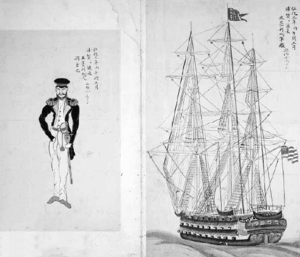USS Columbus (1819)
 USS Columbus
| |
| History | |
|---|---|
| Name | USS Columbus |
| Builder | Washington Navy Yard |
| Launched | 1 March 1819 |
| Commissioned | 7 September 1819 |
| Decommissioned | March 1848 |
| Fate | Scuttled, 20 April 1861 |
| General characteristics | |
| Tonnage | 2480 |
| Length | 191 ft 9 in (58.45 m) |
| Beam | 53 ft 5 in (16.28 m) |
| Draft | 25 ft (7.6 m) |
| Complement | 780 officers and men |
| Armament | 68 × 32-pounder (15 kg) guns, 24 × 42-pounder (19 kg) carronades |
USS Columbus was a 90-gun ship of the line in the United States Navy. She was launched on 1 March 1819 by Washington Navy Yard and commissioned on 7 September 1819, Master Commandant in command.
History[]
Clearing Norfolk, Virginia on 28 April 1820, Columbus served as flagship for Commodore William Bainbridge in the Mediterranean until returning to Boston on 23 July 1821. Serving as a receiving ship after 1833, she remained at Boston in ordinary until sailing to the Mediterranean on 29 August 1842, as flagship for Commodore Charles W. Morgan. On 24 February 1843, she sailed from Genoa, Italy, and reached Rio de Janeiro, Brazil, on 29 July to become flagship of the Brazil Squadron, Commodore Daniel Turner. She returned to New York City on 27 May 1844 for repairs.
After embarking Commodore James Biddle, Commander, East India Squadron, she sailed on 4 June 1845 for Canton, China, where on 31 December Commodore Biddle exchanged ratified copies of the first American commercial treaty with China. Columbus remained there until April 1846, when she sailed for Japan to attempt opening that country to American commerce. She raised Uraga Channel on 19 July in company with Vincennes, but achieved no success.[1] Recalled at the outbreak of the Mexican–American War Columbus reached Valparaíso, Chile, in December and arrived off Monterey, California, 2 March 1847. Too large to be useful in the California operations, the ship sailed from San Francisco on 25 July for Norfolk, arriving on 3 March 1848.
In 1845 the writer, Charles Nordhoff joined the ship as a boy (aged 15), and served for 3 years. He would write later of his adventure in his book. Man-of-War Life: a Boy's Experience in the U. S. Navy, largely autobiographical (Cincinnati, 1855).[2]
At Norfolk Navy Yard, Columbus lay in ordinary until 20 April 1861, when she was sunk by withdrawing Union forces to prevent her falling into Confederate hands.

Sailmaker's plan of USS Columbus

An 1847 illustration of men manning the yards aboard USS Columbus
References[]
- ^ Van Zandt, Howard (1984). Pioneer American Merchants in Japan. Tuttle Publishing. p. 13. ISBN 9994648144.
- ^ Hattendorf, John B. "Nordhoff, Charles the elder". sites.williams.edu. Williams-Mystic. Retrieved 20 June 2018.
- Howard Chapelle, (New York: Norton, 1949), pp. 309–310
- This article incorporates text from the public domain Dictionary of American Naval Fighting Ships. The entry can be found here.
- Ships of the line of the United States Navy
- Ships of the Union Navy
- Ships built in the District of Columbia
- Mexican–American War ships of the United States
- 1819 ships
- Scuttled vessels
- Shipwrecks of the American Civil War
- Shipwrecks of the Virginia coast
- Victorian-era ships of the line
- Maritime incidents in April 1861

